!软件工程练习题3
- 格式:doc
- 大小:181.00 KB
- 文档页数:12
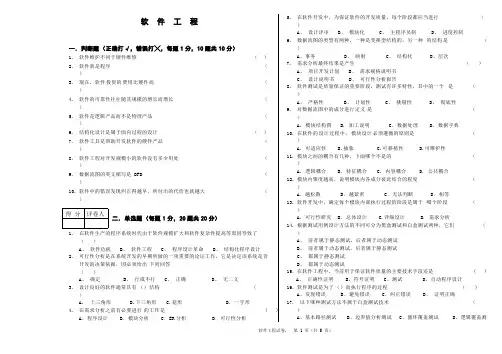
软件工程一.判断题(正确打√,错误打╳,每题1分,10题共10分)1.软件维护不同于硬件维修()2.软件就是程序()3.现在,软件投资的费用比硬件高()4.软件的可靠性往往随其规模的增长而增长()5.软件是逻辑产品而不是物理产品()6.结构化设计是属于面向过程的设计()7.软件工具是帮助开发软件的硬件产品()8.软件工程对开发规模小的软件没有多少用处()9.数据流图的英文缩写是DFD()10.软件中的错误发现纠正得越早,所付出的代价也就越大()二.单选题(每题1分,20题共20分)1.在软件生产的程序系统时代由于软件规模扩大和软件复杂性提高等原因导致了()A、软件危机B、软件工程C、程序设计革命D、结构化程序设计2.可行性分析是在系统开发的早期所做的一项重要的论证工作,它是决定该系统是否开发的决策依据,因必须给出下列回答()A、确定B、行或不行C、正确D、无二义3.设计良好的软件通常具有()结构()A. 上三角形B.下三角形C.瓮形D. 一字形4.在需求分析之前有必要进行的工作是( )A.程序设计 B.模块分析C.ER分析 D.可行性分析5.在软件开发中,为保证软件的开发质量,每个阶段都应当进行()A、设计评审B、模块化C、主程序员制D、进度控制6.数据流图的类型有两种,一种是变换型结构的,另一种的结构是()A、事务B、映射C、结构化D、层次7.需求分析最终结果是产生()A、项目开发计划B、需求规格说明书C、设计说明书D、可行性分析报告8.软件测试是质量保证的重要阶段,测试有许多特性,其中的一个是()A、严格性B、计划性C、挑剔性D、彻底性9.对数据流图中的成分进行定义是()A. 模块结构图B. 加工说明C. 数据处理D. 数据字典10.在软件的设计过程中,模块设计必须遵循的原则是()A. 可适应性B.抽象C.可移植性D.可维护性11.模块之间的耦合有几种,下面哪个不是的()A. 逻辑耦合B. 特征耦合C. 内容耦合D. 公共耦合12.模块内聚度越高,说明模块内各成分彼此结合的程度()A.越松散 B.越紧密 C.无法判断 D.相等13.软件开发中,确定每个模块内部执行过程的阶段是属于哪个阶段()A. 可行性研究B. 总体设计C.详细设计D. 需求分析14.根据测试用例设计方法的不同可分为黑盒测试和白盒测试两种,它们()A、前者属于静态测试,后者属于动态测试B、前者属于动态测试,后者属于静态测试C、都属于静态测试D、都属于动态测试15.在软件工程中,当前用于保证软件质量的主要技术手段还是 ( )A、正确性证明B、符号证明C、测试D、自动程序设计16.软件测试是为了()而执行程序的过程()A、发现错误B、避免错误C、纠正错误D、证明正确17.以下哪种测试方法不属于白盒测试技术()A、基本路径测试B、边界值分析测试C、循环覆盖测试D、逻辑覆盖测得分评卷人试18.单独测试模块时,有时需要一个替身来替代上层模块,此替身被称作是()A.理解模块B.管理模块 C.驱动模块D.传递模块19.软件维护有四种,下面哪一个不是的()A. 完善性维护B. 适应性维护C. 预防性维护D. 测试性维护20.以下哪一项不是面向对象的特征()A、多态性B、继承性C、封装性D、过程调用三.填空题(每空2分,12空共24分)1.在模块结构图中,常用扇入数、扇出数来评价模块结构图,直接调用某一模块的其他模块数称为该模块的(【1】)。
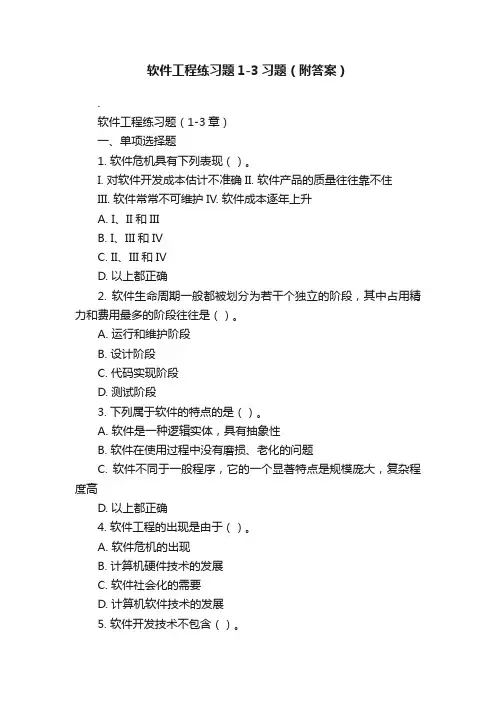
软件工程练习题1-3习题(附答案).软件工程练习题(1-3章)一、单项选择题1. 软件危机具有下列表现()。
I. 对软件开发成本估计不准确II. 软件产品的质量往往靠不住III. 软件常常不可维护IV. 软件成本逐年上升A. I、II和IIIB. I、III和IVC. II、III和IVD. 以上都正确2. 软件生命周期一般都被划分为若干个独立的阶段,其中占用精力和费用最多的阶段往往是()。
A. 运行和维护阶段B. 设计阶段C. 代码实现阶段D. 测试阶段3. 下列属于软件的特点的是()。
A. 软件是一种逻辑实体,具有抽象性B. 软件在使用过程中没有磨损、老化的问题C. 软件不同于一般程序,它的一个显著特点是规模庞大,复杂程度高D. 以上都正确4. 软件工程的出现是由于()。
A. 软件危机的出现B. 计算机硬件技术的发展C. 软件社会化的需要D. 计算机软件技术的发展5. 软件开发技术不包含()。
A. 软件开发方法学B. 软件工程环境C. 软件工具D. 软件质量度度量6 下列属于应用软件的是()。
I. 计算机辅助教学软件II. 软件测试工具III. 办公自动化软件IV. 工程与科学计算软件A. I、II和IIIB. I、III和IVC. II、III和IVD. 以上都正确7. 需求分析阶段最重要的技术文档是()。
A. 设计说明书B. 需求规格说明书C. 可行性分析报告D. 用户手册8. 以下关于数据流图的说法错误的是()。
A. 数据流图舍去了具体的物质,只剩下数据的流动、加工处理和存储B. 数据流图是用作结构化分析的一种工具C. 传统的数据流图中主要由加工、数据源点/终点、数据流、控制流、数据存储组成D. 数据流图的绘制采用自上向下、逐层分解的方法19. 数据字典是软件需求分析阶段的最重要工具之一,其最基本的功能是()。
A. 数据库设计B. 数据通信C. 数据定义D. 数据维护求10. 结构化方法的基本原则是()。
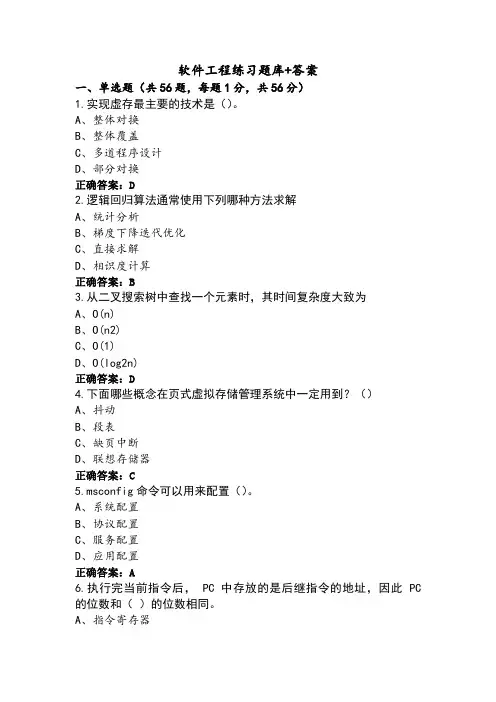
软件工程练习题库+答案一、单选题(共56题,每题1分,共56分)1.实现虚存最主要的技术是()。
A、整体对换B、整体覆盖C、多道程序设计D、部分对换正确答案:D2.逻辑回归算法通常使用下列哪种方法求解A、统计分析B、梯度下降迭代优化C、直接求解D、相识度计算正确答案:B3.从二叉搜索树中查找一个元素时,其时间复杂度大致为A、O(n)B、O(n2)C、O(1)D、O(log2n)正确答案:D4.下面哪些概念在页式虚拟存储管理系统中一定用到?()A、抖动B、段表C、缺页中断D、联想存储器正确答案:C5.msconfig命令可以用来配置()。
A、系统配置B、协议配置C、服务配置D、应用配置正确答案:A6.执行完当前指令后, PC 中存放的是后继指令的地址,因此 PC 的位数和()的位数相同。
A、指令寄存器B、程序状态字寄存器C、主存地址寄存器D、指令译码器正确答案:C7.下列不属于防火墙核心技术的是()。
A、(静态/动态)包过滤技术B、NAT技术C、应用代理技术D、日志审计正确答案:D8.求 2n 个数中的最大值和最小值,最少的比较次数是A、4n/3B、2n-2C、3n-2D、3n/2正确答案:C9.LSTM网络主要解决了RNN中遇到的哪些问题A、不可并行计算,速度提升B、无法处理语言数据C、可以有选择的记忆D、特征编码稀疏问题正确答案:C10.当你感觉到你的Win2003运行速度明显减慢,当打开任务管理器后发现CPU使用率达到了100%,你认为你最有可能受到了()攻击。
A、缓冲区溢出攻击B、木马攻击C、暗门攻击D、DOS攻击正确答案:D11.A方有一对密钥(KA公开,KA秘密),B方有一对密钥(KB公开,KB秘密),A方向B方发送数字签名M,对信息M加密为:M’= KB 公开(KA秘密(M))。
B方收到密文的解密方案是()。
A、KB公开(KA秘密(M’))B、KA公开(KA公开(M’))C、KA公开(KB秘密(M’))D、KB秘密(KA秘密(M’))正确答案:C12.df.head(6)的含义是A、展示数据中前6条数据B、展示数据中第6条数据C、展示数据中后6条数据D、删除数据中的前6条正确答案:A13.关于机器学习与深度学习的描述正确的是A、深度学习算法不需要对数据进行预处理B、深度学习算法只能应用在计算机视觉与自然语言处理中C、深度学习算法优于机器学习算法D、深度学习算法通常迭代速度较慢正确答案:D14.信息安全中PDR模型的关键因素是()。
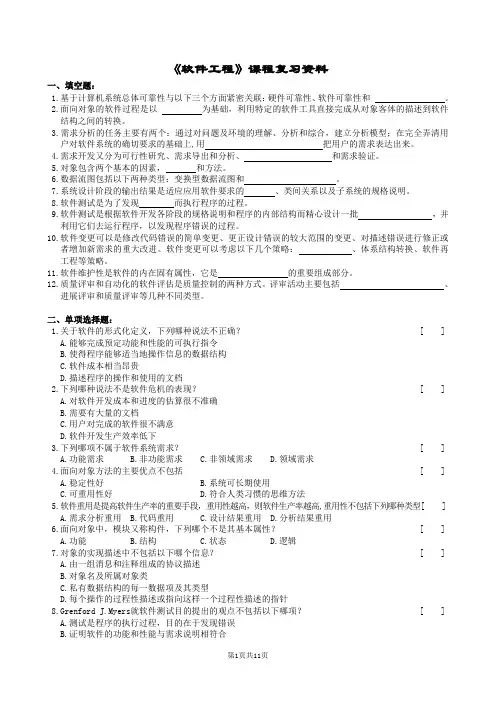
《软件工程》课程复习资料一、填空题:1.基于计算机系统总体可靠性与以下三个方面紧密关联:硬件可靠性、软件可靠性和。
2.面向对象的软件过程是以为基础,利用特定的软件工具直接完成从对象客体的描述到软件结构之间的转换。
3.需求分析的任务主要有两个:通过对问题及环境的理解、分析和综合,建立分析模型;在完全弄清用户对软件系统的确切要求的基础上,用把用户的需求表达出来。
4.需求开发又分为可行性研究、需求导出和分析、和需求验证。
5.对象包含两个基本的因素,和方法。
6.数据流图包括以下两种类型:变换型数据流图和。
7.系统设计阶段的输出结果是适应应用软件要求的、类间关系以及子系统的规格说明。
8.软件测试是为了发现而执行程序的过程。
9.软件测试是根据软件开发各阶段的规格说明和程序的内部结构而精心设计一批,并利用它们去运行程序,以发现程序错误的过程。
10.软件变更可以是修改代码错误的简单变更、更正设计错误的较大范围的变更、对描述错误进行修正或者增加新需求的重大改进。
软件变更可以考虑以下几个策略:、体系结构转换、软件再工程等策略。
11.软件维护性是软件的内在固有属性,它是的重要组成部分。
12.质量评审和自动化的软件评估是质量控制的两种方式。
评审活动主要包括、进展评审和质量评审等几种不同类型。
二、单项选择题:1.关于软件的形式化定义,下列哪种说法不正确? [ ]A.能够完成预定功能和性能的可执行指令B.使得程序能够适当地操作信息的数据结构C.软件成本相当昂贵D.描述程序的操作和使用的文档2.下列哪种说法不是软件危机的表现? [ ]A.对软件开发成本和进度的估算很不准确B.需要有大量的文档C.用户对完成的软件很不满意D.软件开发生产效率低下3.下列哪项不属于软件系统需求? [ ]A.功能需求B.非功能需求C.非领域需求D.领域需求4.面向对象方法的主要优点不包括 [ ]A.稳定性好B.系统可长期使用C.可重用性好D.符合人类习惯的思维方法5.软件重用是提高软件生产率的重要手段,重用性越高,则软件生产率越高,重用性不包括下列哪种类型[ ]A.需求分析重用B.代码重用C.设计结果重用D.分析结果重用6.面向对象中,模块又称构件,下列哪个不是其基本属性? [ ]A.功能B.结构C.状态D.逻辑7.对象的实现描述中不包括以下哪个信息? [ ]A.由一组消息和注释组成的协议描述B.对象名及所属对象类C.私有数据结构的每一数据项及其类型D.每个操作的过程性描述或指向这样一个过程性描述的指针8.Grenford J.Myers就软件测试目的提出的观点不包括以下哪项? [ ]A.测试是程序的执行过程,目的在于发现错误B.证明软件的功能和性能与需求说明相符合C.一个好的测试用例在于能发现至今未发现的错误D.一个成功的测试是发现了至今未发现的错误的测试9.黑盒测试又称为 [ ]A.结构测试B.代码测试C.功能测试D.路径测试10.纠错技术主要是指定位程序错误采用的工具和手段,常用的定位错误方法不包括 [ ]A.插入打印语句B.设置断点C.根据结果推理D.掩蔽部分程序11.为了识别和纠正软件错误、改正软件性能上的缺陷、排除实施中的误使用,应当进行的诊断和改正错误的过程,就叫做 [ ]A.完善性维护B.适应性维护C.改正性维护D.预防性维护12.( )和自动化的软件评估是质量控制的两种方式,其中前者是由一组人员对软件、文档编制和软件制作过程进行评审。
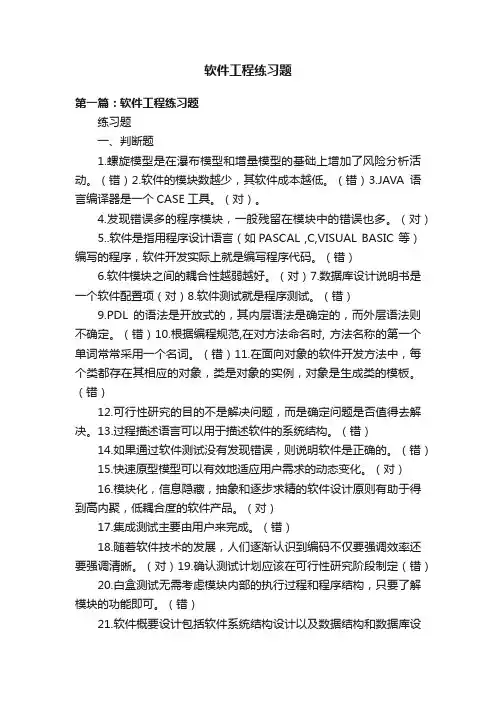
软件工程练习题第一篇:软件工程练习题练习题一、判断题1.螺旋模型是在瀑布模型和增量模型的基础上增加了风险分析活动。
(错)2.软件的模块数越少,其软件成本越低。
(错)3.JAVA语言编译器是一个CASE工具。
(对)。
4.发现错误多的程序模块,一般残留在模块中的错误也多。
(对)5..软件是指用程序设计语言(如PASCAL ,C,VISUAL BASIC 等)编写的程序,软件开发实际上就是编写程序代码。
(错)6.软件模块之间的耦合性越弱越好。
(对)7.数据库设计说明书是一个软件配置项(对)8.软件测试就是程序测试。
(错)9.PDL的语法是开放式的,其内层语法是确定的,而外层语法则不确定。
(错)10.根据编程规范,在对方法命名时, 方法名称的第一个单词常常采用一个名词。
(错)11.在面向对象的软件开发方法中,每个类都存在其相应的对象,类是对象的实例,对象是生成类的模板。
(错)12.可行性研究的目的不是解决问题,而是确定问题是否值得去解决。
13.过程描述语言可以用于描述软件的系统结构。
(错)14.如果通过软件测试没有发现错误,则说明软件是正确的。
(错)15.快速原型模型可以有效地适应用户需求的动态变化。
(对)16.模块化,信息隐藏,抽象和逐步求精的软件设计原则有助于得到高内聚,低耦合度的软件产品。
(对)17.集成测试主要由用户来完成。
(错)18.随着软件技术的发展,人们逐渐认识到编码不仅要强调效率还要强调清晰。
(对)19.确认测试计划应该在可行性研究阶段制定(错)20.白盒测试无需考虑模块内部的执行过程和程序结构,只要了解模块的功能即可。
(错)21.软件概要设计包括软件系统结构设计以及数据结构和数据库设计。
(对)22.一个好的测试用例在于能发现至今未发现的错误。
(对)23.在可行性研究中最难决断和最关键的问题是经济可行性。
(╳)24.耦合是指一个模块内各个元素彼此结合的紧密程度。
(╳)25.一个好的测试用例在于能发现至今未发现的错误。
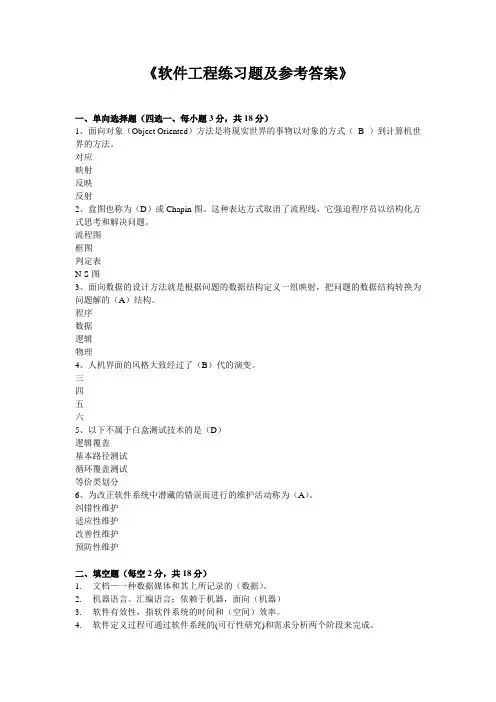
《软件工程练习题及参考答案》一、单向选择题(四选一、每小题3分,共18分)1、面向对象(Object Oriented)方法是将现实世界的事物以对象的方式(B )到计算机世界的方法。
对应映射反映反射2、盒图也称为(D)或Chapin图。
这种表达方式取消了流程线,它强迫程序员以结构化方式思考和解决问题。
流程图框图判定表N-S图3、面向数据的设计方法就是根据问题的数据结构定义一组映射,把问题的数据结构转换为问题解的(A)结构。
程序数据逻辑物理4、人机界面的风格大致经过了(B)代的演变。
三四五六5、以下不属于白盒测试技术的是(D)逻辑覆盖基本路径测试循环覆盖测试等价类划分6、为改正软件系统中潜藏的错误而进行的维护活动称为(A)。
纠错性维护适应性维护改善性维护预防性维护二、填空题(每空2分,共18分)1.文档—一种数据媒体和其上所记录的(数据)。
2.机器语言、汇编语言:依赖于机器,面向(机器)3.软件有效性,指软件系统的时间和(空间)效率。
4.软件定义过程可通过软件系统的(可行性研究)和需求分析两个阶段来完成。
5.软件定义的基本任务是确定软件系统的工程(需求),也就是要搞清“做什么”。
6.为了使用户需求逐步精细化、完全化、一致化,通常采用(需求建模技术)。
04027.一个软件的深度是指其控制的(层数)。
8.以详细设计说明书为输入,将该输入用某种程序设计语言翻译成计算机可以理解并最终可运行的代码的过程叫(编码)过程。
9.软件维护是软件生命周期的(最后)一个阶段。
三、判断题(每小题2分,共24分,错误打X、正确打√)1.缺乏有力的方法学的指导和有效的开发工具的支持,这往往是产生软件危机的原因之一。
(√)2.一个好的开发人员应具备的素质和能力不包括具有良好的书面和口头表达能力。
(X)3.在用户需求分析时观察用户手工操作过程不是为了模拟手工操作过程,而是为了获取第一手资料,并从中提取出有价值的需求。
(√)4.快速原型技术的适用于软件产品要求大量的用户交互、或产生大量的可视输出、或设计一些复杂的算法等场合。
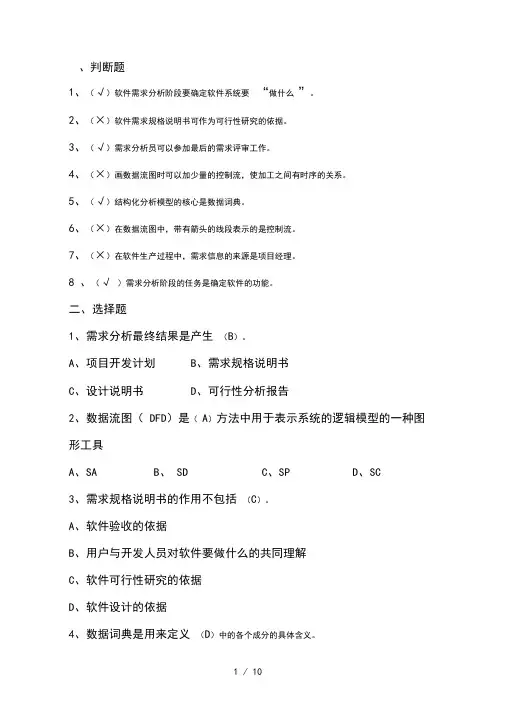
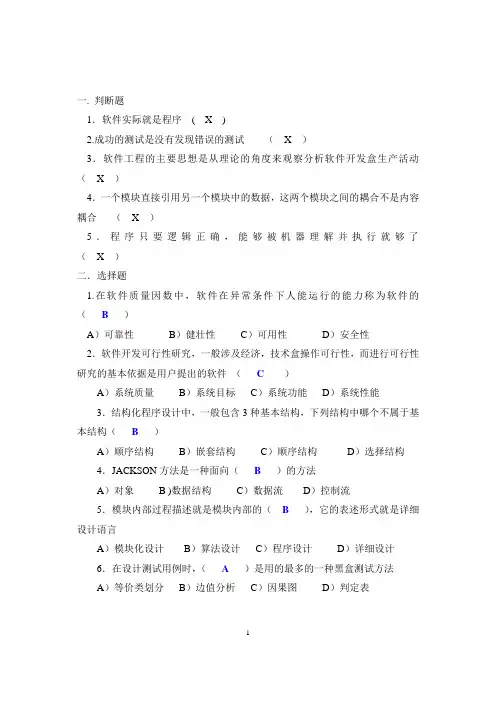
一. 判断题1.软件实际就是程序( X )2.成功的测试是没有发现错误的测试(X )3.软件工程的主要思想是从理论的角度来观察分析软件开发盒生产活动(X )4.一个模块直接引用另一个模块中的数据,这两个模块之间的耦合不是内容耦合(X )5.程序只要逻辑正确,能够被机器理解并执行就够了(X )二.选择题1.在软件质量因数中,软件在异常条件下人能运行的能力称为软件的(B)A)可靠性B)健壮性C)可用性D)安全性2.软件开发可行性研究,一般涉及经济,技术盒操作可行性,而进行可行性研究的基本依据是用户提出的软件(C)A)系统质量B)系统目标C)系统功能D)系统性能3.结构化程序设计中,一般包含3种基本结构,下列结构中哪个不属于基本结构( B )A)顺序结构B)嵌套结构C)顺序结构D)选择结构4.JACKSON方法是一种面向( B )的方法A)对象 B )数据结构C)数据流D)控制流5.模块内部过程描述就是模块内部的(B),它的表述形式就是详细设计语言A)模块化设计B)算法设计C)程序设计D)详细设计6.在设计测试用例时,(A)是用的最多的一种黑盒测试方法A)等价类划分B)边值分析C)因果图D)判定表17软件的可维护性,可使用性, ( B) 是衡量软件质量的几个主要特性A)可靠性B)可复用性C)可理解性D)可修改性8.原型化方法是一种(B)型的设计过程A)自外向内B)自顶向下C)自内向外D)自底向上9.模块(B)定义为受该模块内一个判断影响的所有模块集合A)控制流B)作用域C)宽度D)接口10.程序控制的3种基本结构中,(C)结构可提供程序重复控制A)遍历B)排列 C )循环D)分支三.填空题1.黑箱测试即___性能测试____、白箱测试即_____结构测试______。
2.开发期的主要任务需求分析总体设计,详细设计,编码,测试。
3. 结构化方法将软件生命周期分为__设计__,___开发___,___运行___三个时期.4. 各模块经过单元测试后,将各模块组装起来进行集成测试,以检查与设计相关的软件体系结构的有关问题。
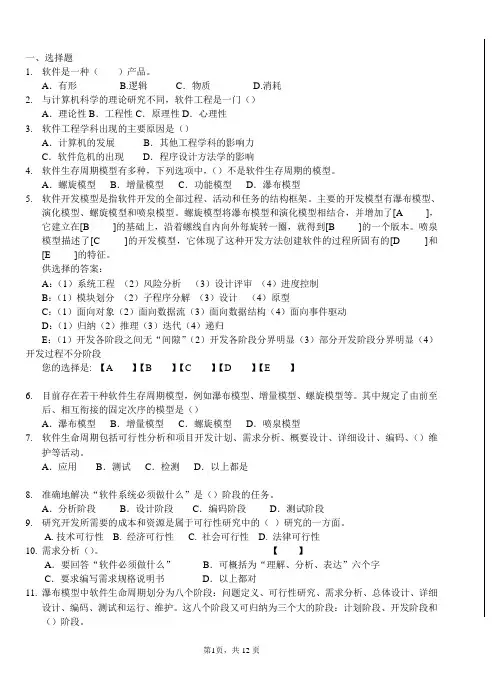
一、选择题1.软件是一种()产品。
A.有形 B.逻辑C.物质 D.消耗2.与计算机科学的理论研究不同,软件工程是一门()A.理论性B.工程性C.原理性D.心理性3.软件工程学科出现的主要原因是()A.计算机的发展B.其他工程学科的影响力C.软件危机的出现D.程序设计方法学的影响4.软件生存周期模型有多种,下列选项中,()不是软件生存周期的模型。
A.螺旋模型B.增量模型C.功能模型D.瀑布模型5.软件开发模型是指软件开发的全部过程、活动和任务的结构框架。
主要的开发模型有瀑布模型、演化模型、螺旋模型和喷泉模型。
螺旋模型将瀑布模型和演化模型相结合,并增加了[A ],它建立在[B ]的基础上,沿着螺线自内向外每旋转一圈,就得到[B ]的一个版本。
喷泉模型描述了[C ]的开发模型,它体现了这种开发方法创建软件的过程所固有的[D ]和[E ]的特征。
供选择的答案:A:(1)系统工程(2)风险分析(3)设计评审(4)进度控制B:(1)模块划分(2)子程序分解(3)设计(4)原型C:(1)面向对象(2)面向数据流(3)面向数据结构(4)面向事件驱动D:(1)归纳(2)推理(3)迭代(4)递归E:(1)开发各阶段之间无“间隙”(2)开发各阶段分界明显(3)部分开发阶段分界明显(4)开发过程不分阶段您的选择是: 【A 】【B 】【C 】【D 】【E 】6.目前存在若干种软件生存周期模型,例如瀑布模型、增量模型、螺旋模型等。
其中规定了由前至后、相互衔接的固定次序的模型是()A.瀑布模型B.增量模型C.螺旋模型D.喷泉模型7.软件生命周期包括可行性分析和项目开发计划、需求分析、概要设计、详细设计、编码、()维护等活动。
A.应用B.测试C.检测D.以上都是8.准确地解决“软件系统必须做什么”是()阶段的任务。
A.分析阶段B.设计阶段C.编码阶段D.测试阶段9.研究开发所需要的成本和资源是属于可行性研究中的()研究的一方面。
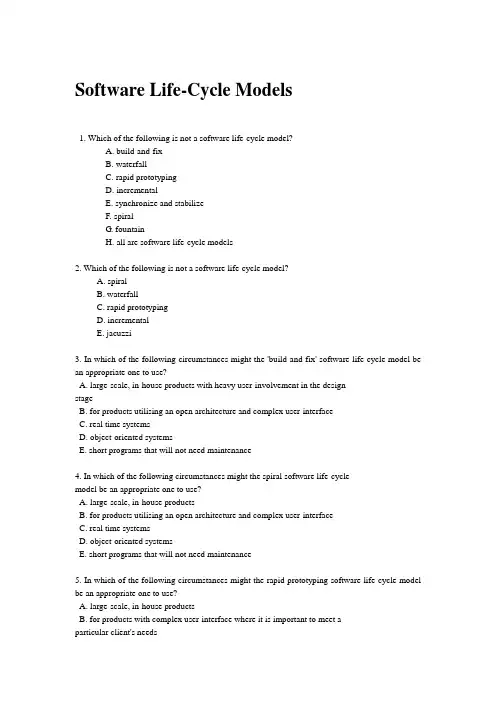
Software Life-Cycle Models1. Which of the following is not a software life-cycle model?A. build-and-fixB. waterfallC. rapid prototypingD. incrementalE. synchronize and stabilizeF. spiralG. fountainH. all are software life-cycle models2. Which of the following is not a software life-cycle model?A. spiralB. waterfallC. rapid prototypingD. incrementalE. jacuzzi3. In which of the following circumstances might the 'build-and-fix' software life-cycle model be an appropriate one to use?A. large-scale, in-house products with heavy user-involvement in the designstageB. for products utilising an open architecture and complex user-interfaceC. real time systemsD. object-oriented systemsE. short programs that will not need maintenance4. In which of the following circumstances might the spiral software life-cyclemodel be an appropriate one to use?A. large-scale, in-house productsB. for products utilising an open architecture and complex user-interfaceC. real time systemsD. object-oriented systemsE. short programs that will not need maintenance5. In which of the following circumstances might the rapid prototyping software life-cycle model be an appropriate one to use?A. large-scale, in-house productsB. for products with complex user-interface where it is important to meet aparticular client's needsC. real time systemsD. object-oriented systemsE. short programs that will not need maintenance6. In which of the following circumstances might the waterfall software life-cycle model be an appropriate one to use?A. large-scale, in-house productsB. for products utilising an open architecture and complex user-interfaceC. real time systemsD. object-oriented systemsE. large document-driven projects requiring a disciplined approach7. What is a drawback of the synchronise-and-stabilise software life-cycle model?A. it is totally unsatisfactory for nontrivial programs.B. it can only be used for large-scale, in-house products.C. the developers have to be competent in risk analysis and risk resolution.D. it is only suitable for object-oriented systems developed in ADA for theDefence industry.E. it has not been widely used other than at Microsoft.8. Which feature of the waterfall software life-cycle model allows modifications to be made to the deliverables produced at an earlier stage?A. the cascade effectB. re-selection of the best solution, of those developed in parallel, from theprevious stageC. risk analysis and risk resolutionD. no modifications can be made as each stage once signed off by the clientsand developers becomes definitiveE. feedback loops9. A critical point of the waterfall software life-cycle model is that:A. the cascade effect ensures that the product gains momentum through each phase in its development thus ensuring buy-in from the clients.B. re-selection of the best solution, of those developed in parallel, from the previous stage.C. risk analysis and risk resolution are explicitly defined for each stage.D. no modifications can be made as each stage once signed off by the clients and developers becomes definitive.E. no phase is complete until the documentation for that phase has been completed and the deliverables for that phase have been approved by the SQA group.10. Which of the following statements about the waterfall software life-cyclemodel is true?A. Testing is a separate phase that is only conducted once the product isconstructed.B. Once the product is delivered to the client there is no need to maintain the documentation.C. Its strength is in the written documentation available to the client in astyle that makes the nature and characteristics of the product to be deliveredhighly visible.D. No modifications can be made as each stage once signed off by the clientsand developers becomes definitive.E. All of these statements are false.11. To a certain extent the use of the rapid prototyping software life-cycle model is to overcome one of the weaknesses of the waterfall model. To this extent the working model is primarily designed to be evaluated by the:A. developersB. analystsC. test teamD. managersE. end-users12. Which property of the rapid prototype is not important?A. the speed with which it can be developedB. the speed with which it can be modifiedC. its ability to determine the client's real needsD. the insights that the design team can gain from it, even if they are of the'how not to do it' varietyE. its internal structure13. Introducing rapid prototyping into an organization as a front-end to the waterfall model has an additional advantage. It will give management the opportunity to:A. dehire employees assigned to unsuccessful projects.B. remove the unnecessary step of producing documentation.C. put the onus of specifying the requirements fully on the users as they can no longer use the excuse that they did not understand the documentation to request changes to their 'needs'.D. assess the technique while minimising the associated risk.E. All of these are advantages.14. In one sense the Incremental model is a contradiction in terms.A. Like a house, each build (i.e. tradesmen such as plumbers, electricians) must complete their work until the whole (product) can be used.B. It is necessary to change (i.e. maintain) initial builds before the new ones can be added to it. Thus you have to maintain the product before it is completed, thus increasing the amount of work.C. A model is meant to represent one (simplistic) view of the whole. In contrast the incremental model is based on stand-alone building blocks and a view of the overall shape cannot be seen until the last build (block) is in place.D. The initial contract specifies the entire product to be built and the client is required to makeprogress payments every time period (usually monthly) as all increments may be worked on simultaneously and none may delivered within a time increment.E. The developer must design the product as a whole but simultaneously view it as a sequence of builds.15. An additional advantage of the Incremental model is that:A. the customer pays for the entire product initially although the costs (mostly labour) are accrued over time.B. work can begin quickly on the first build (justifying the pre-payment made by the client), although this may lead to more work for the subsequent builds as they are integrated into the earlier ones.C. stability is introduced early in the product's history once the overall architecture is specified and no changes are incorporated until after the last of the builds.D. the client has more time to introduce changes to the organization and there is no need for the parallel runs that accompany the big-bang approach typified by the waterfall and prototyping models.E. as the design is flexible enough to support incremental builds, enhancements undertaken during the maintenance phase can be easily incorporated as they are additional builds.16. An advantage of the Incremental model is that:A. change and adaptation are natural to the modelB. an operational quality product is delivered to the client at each stage.C. as the design is flexible enough to support incremental builds, enhancementsundertaken during the maintenance phase can be easily incorporated as they areadditional builds.D. it reduces the traumatic effect of introducing changes to the organizationas each new increment builds upon the work delivered in the previous one.E. All of these are advantages of the incremental model.17. A disadvantage of the Incremental model is that:A. clients are not billed until the last build is completed.B. it is not easy to accommodate changes that occur due to external(competitive, social and regulatory) forces.C. the model can easily degenerate into the 'build-and-fix' approach.D. There are no advantages of the incremental model - the approach has largelybeen discredited.E. All of these are disadvantages of the incremental model.18. The extreme programming software life-cycle model is an adaptation of the ____________ model.A. build-and-fixB. waterfallC. rapid prototypingD. incrementalE. spiral19. In extreme programming there is no overall design phase before the various builds are constructed. Instead the design is modified while the product is being built. This procedure is termed:A. regressionB. synchronizationC. stabilizationD. refactoringE. incrementing20. In extreme programming, the first step is that the software development teamdetermine the various features that the client would like the product to support. These are termed:A. buildsB. function pointsC. feature pointsD. storiesE. increments21. In extreme programming, what is the first step in a task that is to be part of a build?A. requirement definitionB. designingC. testingD. programmingE. documentation22. Which of the following is not a feature of extreme programming (XP)?A. computers of the XP team are set up in the centre of a large roomB. a client works with the XP team at all timesC. no individual can work overtime for more than 2 successive weeksD. there is no specialization, all members work on specification, design, codeand testingE. there is no overall design phaseF. None. That is, all of these are features of extreme programming.23. The synchronise-and-stabilise software life-cycle model is an adaptation ofthe ____________ model.A. build-and-fixB. waterfallC. rapid prototypingD. incrementalE. spiral24. The spiral software life-cycle model is an adaptation of the ____________model(s).A. build-and-fixB. waterfallC. rapid prototypingD. incrementalE. all of the above25. The aim of the synchronisation stage of the synchronise-and-stabilisesoftware life-cycle model is to:A. repair faults found in any earlier releasesB. freeze change requests so that the build can be stabilisedC. draw up the specification documentD. release the current version(s) of the product to the clients based on theversions and releases installed at their various sites.E. put the partially completed components together and test and debug theresulting product26. A disadvantage of the synchronise-and-stabilise software model is that:A. the model cannot be used if the initial specification is incomplete.B. the developers cannot gain an insight into the operation of the product until a build is complete.C. the model can easily degenerate into the 'build-and-fix' approach.D. There are no advantages of the synchronise-and-stabilise model - the approach has largely been discredited.E. All of these are disadvantages of the incremental model.F. the approach needs the existence of a disciplined change control operation before it can be put in place. Thus it is unlikely to be used by the many small software development organizations that typify the industry.27. An example of the risk involved in software development is:A. key personnel may resign before the product is complete.B. the manufacturer of critical components (e.g. the hardware associated with areal-time system) may go bankrupt.C. technology changes may render the product obsolete.D. competitors may market a fully functional lower-cost equivalent package.E. All of these are risks involved in software development.28. A simple way of looking at the spiral software life-cycle model is as a _________ model with each phase preceded by risk analysis.A. build-and-fixB. waterfallC. rapid prototypingD. incrementalE. Synchronize and stabilize29. A simple way of looking at the spiral software life-cycle model is as a waterfall model with each phase proceeded by:A. build-and-fixB. freezingC. synchronizationD. testingE. risk analysis30. There are many risks associated with software development. Which of the following represents the soundest scenario by way of resolving risk?A. adding more people to the project to ensure that it will be completed in time.B. freezing all outstanding change requests until every currently known fault is repairedC. insisting on the use of the waterfall technique to document each stage of a project before agreeing to proceed to the next phase.D. increase the amount of testing immediately prior to the release of the product.E. building a prototype to test say a routing algorithm, the failure of which would otherwise cause widespread disruption to the business.31. Which of the following are limitations of the spiral model?A. It is suited to internal development. For instance, termination of acontract with an external developer may lead to costly litigation.B. For small projects the cost of conducting risk analysis may not be warrantedwhen put alongside the total cost of the product.C. Members of the development team may not be competent risk analysts.D. All of these are limitations on or restrictions to the use of risk analysis.E. There are no limitations on or restrictions to the use of risk analysis.32. How is maintenance treated the spiral model of software development?A. It is not treated at all. This is one of the major limitations of the spiralmodel.B. Maintenance is the last of the four quadrants in the model.C. Maintenance is the first of the four quadrants in the model..D. Maintenance is treated within each quadrant of the model.E. Maintenance is treated as a further iteration of the model.33. A common feature(s) of object-oriented life cycle models is/are:A. iterationB. parallelism (overlap of activities)C. incremental developmentD. All of these are featuresE. None of these are features34. An intrinsic property of software production and the object-oriented paradigm in particular is:A. iterationB. the existence of bugsC. testingD. crisis managementE. All of these are features35. In an analysis of some of the life cycle models, Schach concludes that the_____________ model is the best.A. waterfallB. incrementalC. object-orientedD. spiralE. none of these are "the" best.。
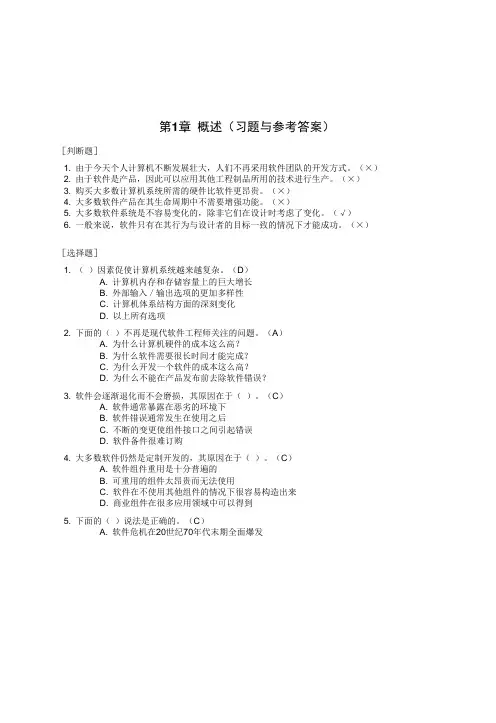
第1章概述(习题与参考答案)[判断题]1. 由于今天个人计算机不断发展壮大,人们不再采用软件团队的开发方式。
(×)2. 由于软件是产品,因此可以应用其他工程制品所用的技术进行生产。
(×)3. 购买大多数计算机系统所需的硬件比软件更昂贵。
(×)4. 大多数软件产品在其生命周期中不需要增强功能。
(×)5. 大多数软件系统是不容易变化的,除非它们在设计时考虑了变化。
(√)6. 一般来说,软件只有在其行为与设计者的目标一致的情况下才能成功。
(×)[选择题]1. ()因素促使计算机系统越来越复杂。
(D)A. 计算机内存和存储容量上的巨大增长B. 外部输入/输出选项的更加多样性C. 计算机体系结构方面的深刻变化D. 以上所有选项2. 下面的()不再是现代软件工程师关注的问题。
(A)A. 为什么计算机硬件的成本这么高?B. 为什么软件需要很长时间才能完成?C. 为什么开发一个软件的成本这么高?D. 为什么不能在产品发布前去除软件错误?3. 软件会逐渐退化而不会磨损,其原因在于()。
(C)A. 软件通常暴露在恶劣的环境下B. 软件错误通常发生在使用之后C. 不断的变更使组件接口之间引起错误D. 软件备件很难订购4. 大多数软件仍然是定制开发的,其原因在于()。
(C)A. 软件组件重用是十分普遍的B. 可重用的组件太昂贵而无法使用C. 软件在不使用其他组件的情况下很容易构造出来D. 商业组件在很多应用领域中可以得到5. 下面的()说法是正确的。
(C)A. 软件危机在20世纪70年代末期全面爆发B. 当前先进的软件工程方法已经解决了软件危机的问题C. 软件危机是指在计算机软件的开发和维护过程中遇到的一系列严重问题D. 软件危机是指在软件产品中存在一系列的质量问题6. 软件工程的基本目标是()。
(B)A. 消除软件固有的复杂性B. 开发高质量的软件C. 努力发挥开发人员的创造性潜能D. 更好地维护正在使用的软件产品7. ()是将系统化的、规范的、可定量的方法应用于软件的开发、运行和维护的过程,它包括方法、工具和过程三个要素。
《软件工程》试题(第3套)第一部分选择题一、单项选择题(本大题共20小题,每小题1分,共20分)1.需求分析中,开发人员要从用户那里解决的最重要的问题是( )。
A、要让软件做什么B、要给该软件提供哪些信息C、要求软件工作效率怎样D、要让该软件具有何种结构2.DFD中的每个加工至少有( )。
A、一个输入流或一个输出流B、一个输入流和一个输出流C、一个输入流D、一个输出流3.详细设计与概要设计衔接的图形工具是( )。
A、DFD图B、SC图C、PAD图D、程序流程图4.确认测试中,作为测试依据的文档是( )。
A、需求规格说明书B、设计说明书C、源程序D、开发计划5.为了适应软硬件环境变化而修改软件的过程是( )。
A、校正性维护B、完善性维护C、适应性维护D、预防性维护6.用于描述对象模型的工具是( )。
A、数据流图B、结构图C、状态图D、对象图7.软件质量保证应在( )阶段开始。
A.需求分析B.设计C.编码D.投入使用8.程序的三种基本控制结构的共同特点是( )A.不能嵌套使用 B.只能用来写简单程序C.已经用硬件实现D.只有一个入口和一个出口9. 在软件开发的各种资源中,()是最重要的资源。
A 开发工具B 方法C 硬件环境D 人员10. 协作图反映收发消息的对象的结构组织,它与()是同构的。
A 用例图B 类图C 活动图D 时序图11.黑盒测试在设计测试用例时,主要需要研究( )A.需求规格说明与概要设计说明B.详细设计说明C.项目开发计划D.概要设计说明与详细设计说明12、 CMM提供了一个框架,将软件过程改进的进化步骤组织成5个成熟度等级。
除第1级外,每个等级都包含了实现该成熟度等级目标的若干()。
A 关键实践B 关键过程域C 软件过程能力D 软件过程13. 详细设计与概要设计衔接的图形工具是( )A. DFD图B. 程序图C. PAD图D. SC图14. 测试的关键问题是 ( )A. 如何组织对软件的评审B. 如何验证程序的正确性C. 如何采用综合策略D. 如何选择测试用例15.研究开发所需要的成本和资源是属于可行性研究中的( )研究的一方面。
软件工程考试题三一、选择题,请从四个可选项中选择正确答案。
(60分,每题3分)1.软件工程四个层次由下至上是(),它们的顺序不能互换。
A.质量层、过程层、方法层、工具层B.过程层、方法层、质量层、工具层C.方法层、过程层、质量层、工具层D.方法层、质量层、过程层、工具层2.根据软件工程的7条基本原理判断下面正确的选项是()。
A.软件错误发现的时机不重要,重要的是错误的严重程度B.软件错误只能通过运行代码才能发现C.软件错误发现的越早改正的成本越低D.。
需求阶段一般不会引入错误3.下列有关标准的符号,属于国内标准的是( )A. ZGB. GBC.GND.CB4.经济可行性研究的主要内容包括()。
A.开发过程B.开发工具C.风险分析D. 效益分析5.()定义了用户使用该软件要完成的任务。
A.用户需求B.业务需求C.性能需求D.功能需求6.数据流程图上的数据流必须封闭在()之间。
A.外部过程B.内部数据C.内部过程D.外部实体7.按照模块独立性,耦合程度由强至弱正确的顺序是()。
A.外部耦合、控制耦合、数据耦合B.控制耦合、数据耦合、外部耦合C.外部耦合、数据耦合、控制耦合D.数据耦合、外部耦合、控制耦合8.PDL是描述处理过程( )。
A.做什么B.为什么做C.怎么做D.对谁做9.面向对象的这种()模式与人们对客观世界的认识规律相符,从而使得面向对象技术在软件工程领域中获得了广泛的应用。
A.主体/动作B.主体/对象C.主体/类D.对象/属性10.()是从用户的观点描述系统功能,它由一组用例、参与者以及它们之间关系所组成。
A.类图B.对象图C.顺序图D.用例图11.面向对象分析和设计涉及到三个方面的内容:()、一系列有效的分析步骤和一个方便易用的建模工具。
A.一套完善的建模符号B.有效的数据结构C.灵活的体系结构D.稳定的系统架构12.确定角色是()的任务。
A.对象模型B.用例模型C.动态模型D.交互模型13.面向对象设计首先要进行高层设计:确定系统的总体结构和风格,构造系统的(),将系统划分成不同的子系统。
第3章习题一、选择题1)下列哪个选项不是需求分析的特点A)问题确定难C)交流共识难B)需求稳定性D)完备一致难2)软件质量必须从需求分析开始,在()加以保证。
A)开发之前B)开发之后C)可行性研究过程中D)整个开发过程3)SA 方法的基本思想是A)自底向上逐步抽象B)自底向上逐步分解C)自顶向下逐步分解D)自顶向下逐步抽象4)DFD 是常用的进行软件需求分析的图形工具,其基本符号是A)输入、输出、外部实体和加工B)变换、加工、数据流和存储C)加工、数据流和数据存储和外部实体D)变换、数据存储、加工和数据流5)判定表和判定树是DFD 中用以描述加工的工具,他通常描述的对象是A)逻辑判断B)层次分解C)操作条目D)组合组件6)系统流程图用于可行性分析中的( ) 的描述A)当前运行系统B)当前逻辑模型C)目标系统D)新系统7)在程序的描述和分析中,用于指明数据来源、流向和处理的辅助图形是A)数据结构图B)DFD C)业务结构图D)其他图8)U/C 矩阵是用来进行()的方法A)系统开发B)系统分析C)子系统划分D)系统规划9)需求规格说明书的作用不应该包括BA)软件设计的依据B)用户与开发人员对软件要做什么的共同理解C)软件验收的依据D)软件可行性研究的依据10)业务流程图是描述( ) 的工具A)逻辑系统的处理过程C)某个软件运行过程B)程序系统的处理过程D)某个具体业务的处理过程11)下面关于需求分析目的叙述,哪个选项是错误A)逐一细化软件的设计步骤B)面向用户获取并分析需求C)检查和解决不同需求间的矛盾,尽量达到均衡和优化D)确定软件的边界,以及软件与环境的相互作用方式12)下列哪个选项不是结构化分析具体步骤A)构建原系统物理模型C)建立新系统物理模型B)抽象原系统逻辑模型D)进一步补充和优化13)下面关于需求报告和需求规格说明书两者之间区别的叙述,哪个选项是错误的A)用户需求报告对外,需求规格说明书对内使用B)用户需求报告是合同的产物,需求规格说明书是立项建议书的产物C)通过用户需求报告可产生需求规格说明书D)需求规格说明书从业务领域的角度定义高层的需求14)下列哪个选项不属于需求分析的任务A.确定总体目标及组织结构1附件3:阶段测试题排版格式B.深入领域分析,画出业务流程图C.确定系统逻辑模型D.确定功能需求,完成功能结构图及点列表15)下列哪个选项不属于需求分析的任务A.获取性能需求,列出性能点列表B.明确系统规模和目标C.确定系统运行环境及界面D.修正开发计划和新系统方案16)下面是关于开展需求分析工作技巧的叙述,哪个选项是错误的A) 需求分析是分析师与设计师双方进行配合的项目,需要密切交流合作。
《软件工程》习题3一、单项选择题1. 在下列工具与环境中()属于较早期的CASE。
A、基于信息工程CASEB、人工智能CASEC、结构的基于图形CASED、集成的CASE环境2. 用黑盒技术设计测试用例的方法之一为()。
A、基本路径测试B、边界值分析测试C、循环覆盖测试D、逻辑覆盖测试3. 下列()做法会导致不利的语句结构。
A、避免使用ELSE GOTO结构B、模块功能尽可能单一化,模块间的耦合能够清晰可见C、对递归定义的数据结构尽量不再使用递归过程D、利用信息隐蔽,确保每一个模块的独立性4.程序设计语言的工程特性之一为()。
A、软件的可重用性B、数据结构的描述性C、抽象类型的描述性D、数据库的易操作性5.()意味着一个操作在不同的类中可以有不同的实现方式。
A、封装B、多继承性C、类的复用D、多态性6. 面向对象模型主要由以下()模型组成。
A、对象模型、动态模型、功能模型B、对象模型、数据模型、功能模型C、数据模型、动态模型、功能模型D、对象模型、动态模型、数据模型7. 只有单重继承的类层次结构是()层次结构。
A、网状型B、树状型C、星型D、环型8. 软件测试计划开始于需求分析阶段,完成于()阶段。
A、需求分析B、软件设计C、软件实现D、软件测试9. 详细设计的结果基本决定了最终程序的()。
A、质量B、可维护性C、运行速度D、代码的规模10. 只有单重继承的类层次结构是()层次结构。
A、网状型B、星型C、树型D、环型11. 用于描述对象模型的工具是()。
A、数据流图B、结构图C、状态图D、对象图12. 为了提高模块的独立性,模块内部最好是()。
A、逻辑内聚B、时间内聚C、功能内聚D、通信内聚13. 瀑布模型的存在问题是()。
A、用户容易参与开发B、缺乏灵活性C、用户与开发者易沟通D、适用可变需求14. 下列工具中,不属于详细设计工具的是()。
A、表格工具B、图形工具B、测试工具D、语言工具15. 在大型数据处理系统的功能分析与设计中,数据库的概念设计对应于系统开发的()。
软件工程复习题三一、单项选择题本大题共20小题,每小题1分,共20分在每小题列出的四个备选项中只有一个是符合题目要求的,请将其代码填写在题后的括号内;错选、多选或未选均不得分;1.以文档作为驱动,适合于软件需求很明确的软件项目的生存周期模型是 CA.喷泉模型B.增量模型C.瀑布模型D.螺旋模型2.为每个模块完成的功能进行具体描述,把功能描述转变为精确的、结构化的过程描述的阶段是 BA.概要设计B.详细设计C.编码D.测试3.软件开发环境是支持软件整个生存周期各阶段或部分阶段的相关的一组 DA.软件模型B.软件过程C.软件工程D.软件工具4.从结构化的瀑布模型看,在软件生存周期的几个阶段中,对软件的影响最大是 CA.详细设计阶段B.概要设计阶段C.需求分析阶段D.测试和运行阶段5.数据字典是软件需求分析阶段所采用的最重要工具之一,其最基本的功能是 AA.数据定义B.数据通讯C.数据库设计D.数据维护6.系统定义明确之后,应对系统的可行性进行研究;可行性研究包括BA.软件环境可行性、技术可行性、经济可行性、社会可行性B.经济可行性、技术可行性、社会可行性C.经济可行性、社会可行性、系统可行性D.经济可行性、实用性、社会可行性7.模块内聚性最好的是 CA.逻辑内聚B.时间内聚C.功能内聚D.通信内聚8.设计软件结构一般不.确定 DA.模块之间的接口B.模块间的调用关系C.模块的功能D.模块内的局部数据9.软件结构化设计中,好的软件结构应该力求做到 BA.顶层扇出较少,中间扇出较高,底层模块低扇入B.顶层扇出较高,中间扇出较少,底层模块高扇入C.顶层扇入较少,中间扇出较高,底层模块高扇入D.顶层扇入较少,中间扇入较高,底层模块低扇入10.两个模块都使用同一张数据表,模块间的这种耦合称为 AA.公共耦合B.内容耦合C.数据耦合D.控制耦合11.软件可靠性是软件在给定的时间内,在规定的环境条件下系统完成所指定功能的 CA.可用性B.适应性C.概率D.可移植性12.划分模块时,下列说法正确的是 AA.作用范围应在其控制范围之内B.控制范围应在其作用范围之内C.作用范围与控制范围互不包含D.作用范围与控制范围不受限制13.重用率高的模块在软件结构图中的特征是 BA.扇出数大B.扇入数大C.扇出数小D.内聚性高14.构造原型时,主要考虑 BA.全部功能B.原型要体现的特征C.全部细节D.全部需求15.快速原型模型的主要特点之一是 DA.开发完毕才见到产品B.及早提供全部完整的软件产品C.开发完毕后才见到工作软件D.及早提供工作软件估算模型是 BA.模块性成本模型B.结构性成本模型C.动态单变量模型D.动态多变量模型17.与软件开发需求分析、设计及编码阶段相对应的软件测试步骤是DA.组装测试、确认测试、单元测试B.单元测试、组装测试、确认测试C.单元测试、确认测试、组装测试D.确认测试、组装测试、单元测试18.软件维护产生的副作用是指 CA.开发时的错误B.隐含的错误C.因修改软件而造成的错误D.运行时的误操作19.比较理想的可重用软件结构是 BA.子程序库B.源代码及文件C.对象D.类20.面向对象建模得到的三个模型,其中核心的模型是 AA.对象模型B.功能模型C.逻辑模型D.动态模型二、填空题本大题共10小题,每小题2分,共20分请在每小题的空格中填上正确答案;错填、不填均不得分;21.计算机程序及其说明程序的各种文档称为_软件____;用来描述系统的功能活动及其联系,建立系统的_功能模型____;23.结构化分析方法是一种面向__数据流___的开发方法;24.成本——效益分析的目的是从__经济___角度评价开发一个新的软件项目是否可行;25.模块有四个基本属性,其中反映它的内部特性的是_逻辑____;26.确认测试可以发现软件系统是否符合用户的__功能和性能___要求;27.在算法描述工具中,__PAD___是一种由左往右展开的二维树型结构;28.动态模型是与时间和变化有关的系统性质,它描述了系统的_控制____结构;29.成本估算方法中,有自顶向下估算方法、自底向上估算方法和_差别估算____方法;30.随着软硬件环境变化而修改软件的维护活动称为_适应性维护____;三、名词解释题本大题共5小题,每小题3分,共15分31.软件生存周期模型软件生存周期模型是描述软件开发过程中各种活动如何执行的模型;软件生存周期模型确立了软件开发才演绎中各阶段的次序限制以及各阶段活动的准则,确立开发过程所遵守的规定和限制,便于各种活动的协调以及各种人员的有效通信,有利于活动重用和活动管理; 32.模块模块在程序中是数据说明,可执行语句等程序对象的集合,或者是单独命名和编址的元素,如高级程序语言中的过程、函数和子程序等;在软件的体系结构中,模块是可组合、分解和更换的单元;33.可维护性软件可维护性是指软件能够被理解、校正、适应及增强功能的容易程度;可维护性可用7个质量特性来衡量,即可理解性、可测试性、可修改性、可靠性、可移植性、可使用性和效率;34.继承性继承性是子类自动共享父类数据结构和方法的机制,这是类之间的一种关系;在定义和实现一个类的时候,可以在一个已经存在的类的基础之上来进行,把这个已经存在的类所定义的内容作为自己的内容,并加入若干新的内容;35.投资回收期把风资回收期是衡量一个开发工程价值的经济指标,投资回收期就是累积的经济效益等于最初投资所需要的时间;四、简答题本大题共4小题,每小题5分,共20分36.简述软件危机产生的原因;1.软件的规模越来越大,结构越来越复杂;2.软件开发的管理困难;由于软件规模大,结构复杂,又具有无形性,导致管理困难,进度控制困难,质量控制困难,可靠性无法保证;3.软件开发费用不断增加;4.软件开发技术、开发工具落后,生产率提高缓慢5.生产方式落后,软件仍然采用个体手工方式开发37.简述需求分析的概念及需求分析的基本任务;38.简述数据流图的分类及每一类的特点;数据流图有两类,变换型数据流图和事务型数据流图,变换型数据流图是由输入、处理、输出三部分组成,因此变换型数据流图是一个顺序结构;事务型数据流图特征:事务处理中心将它的输入流分离成许多发散的数据流,形成许多加工路径,并根据输入的值选择其中一个路径来执行;39.简述建立对象模型的过程;五、应用题本大题共2小题,第40小题l3分,第41小题12分,共25分40.某公司承担空中和地面运输业务;计算货物托运费的比率规定如下:空运:如果货物重量小于等于2kg,则一律收费6元;如果货物重量大于2kg而又小于等于20kg,则收费3元/kg;如果货物重量大于20kg,则收费4元/kg;地运:若为慢件,收费为1元/kg;若为快件,当重量小于等于20kg 时,收费为2元/kg;当货物重量大于20kg时,则收费为3元/kg;下列步骤是应用判定表方法描述以上案例的过程;请根据题意,在条件取值表的“取值”列中填入相应内容,并在初步判定表和简化后的判定表中填入条件取值表中规定的符号;1条件取值表2初步判定表3简化后的判定表41.某一8位微机,其八进制常数定义为:以零开头的数是八进制数,其值的范围是-177~177,如05,0127,-065;下列步骤是应用等价类划分法设计上述案例测试用例的过程;请根据题意,在划分等价类表中的编号⑩和编号错误!处填入相应内容,并在合理等价类测试用例表和不合理等价类测试用例表中的“期望结果”与“覆盖范围”二列中填入相应的内容;1划分等价类并编号2为合理等价类设计测试用例3为不合理等价类设计测试用例。
软件工程(本)阶段练习三华东理工大学网络教育学院《软件工程(本)》阶段练习三一、判断题(每题1分,共10分;正确打“√”,错误打“×”)1、Jackson结构图只能描述数据结构,不能描述程序结构。
( ×)2、HIPO图是由一张层次图和一组IPO图组成的。
( √)3、源程序的文档化就是软件的文档化。
( ×)4、问题分析图(PAD)是一种常用的详细设计描述工具。
( √)5、Jackson方法是一种面向对象的软件设计方法。
( ×)6、把一个软件系统划分成多个模块的目的是为了降低软件系统的复杂性。
( √)7、耦合性是一个用来衡量模块内部各个元素彼此结合紧密程度的度量指标。
( ×)8、将软件系统划分为模块时,应尽量做到高内聚低耦合,提高模块的独立性。
( √)9、面向数据流的设计以需求分析阶段产生的数据流图为基础,按一定的步骤将其映射为软件结构。
( √)10、软件结构图是软件系统的模块层次图,它反映了整个系统的功能实现。
( √)二、单项选择题(每空1分,本大题共30分)1、在模块化软件设计中,划分程序模块通常遵循的基本原则是:使各模块间的耦合性①;使各模块内部的内聚度②。
A、尽可能强B、尽可能弱C、适中D、视情况而定2、面向数据流的设计方法把数据流图(DFD)划分为变换型和③两大类,并提出了对应于这两类结构的分解方法。
A、控制型B、处理型C、事务型D、功能型3、模块化的目的是为了④。
A、增加内聚性B、提高易读性C、降低复杂性D、减少耦合性4、三种可能的模块耦合是:⑤:例如一个模块直接引用另一个模块中的数据。
⑥:例如一个模块把控制另一个模块执行流程的逻辑量作为参数传递给另一个模块。
⑦:例如一个模块把一个数据量传递给另一个模块。
其中⑧的耦合性最强。
A、数据耦合B、内容耦合C、标记耦合D、控制耦合E、公共耦合5、使用结构化分析(SA)方法时,可以得到____⑨______,这种方法采用的基本手段是_____⑩______;使用面向数据流的设计方法(SD)时,可以得到__⑾___,并可以实现_______⑿______,而使用Jackson方法可以实现_______⒀_________。
一、选择题1.软件是一种()产品。
A.有形 B.逻辑C.物质 D.消耗2.与计算机科学的理论研究不同,软件工程是一门()A.理论性B.工程性C.原理性D.心理性3.软件工程学科出现的主要原因是()A.计算机的发展B.其他工程学科的影响力C.软件危机的出现D.程序设计方法学的影响4.软件生存周期模型有多种,下列选项中,()不是软件生存周期的模型。
A.螺旋模型B.增量模型C.功能模型D.瀑布模型5.软件开发模型是指软件开发的全部过程、活动和任务的结构框架。
主要的开发模型有瀑布模型、演化模型、螺旋模型和喷泉模型。
螺旋模型将瀑布模型和演化模型相结合,并增加了[A ],它建立在[B ]的基础上,沿着螺线自内向外每旋转一圈,就得到[B ]的一个版本。
喷泉模型描述了[C ]的开发模型,它体现了这种开发方法创建软件的过程所固有的[D ]和[E ]的特征。
供选择的答案:A:(1)系统工程(2)风险分析(3)设计评审(4)进度控制B:(1)模块划分(2)子程序分解(3)设计(4)原型C:(1)面向对象(2)面向数据流(3)面向数据结构(4)面向事件驱动D:(1)归纳(2)推理(3)迭代(4)递归E:(1)开发各阶段之间无“间隙”(2)开发各阶段分界明显(3)部分开发阶段分界明显(4)开发过程不分阶段您的选择是: 【A 】【B 】【C 】【D 】【E 】6.目前存在若干种软件生存周期模型,例如瀑布模型、增量模型、螺旋模型等。
其中规定了由前至后、相互衔接的固定次序的模型是()A.瀑布模型B.增量模型C.螺旋模型D.喷泉模型7.软件生命周期包括可行性分析和项目开发计划、需求分析、概要设计、详细设计、编码、()维护等活动。
A.应用B.测试C.检测D.以上都是8.准确地解决“软件系统必须做什么”是()阶段的任务。
A.分析阶段B.设计阶段C.编码阶段D.测试阶段9.研究开发所需要的成本和资源是属于可行性研究中的()研究的一方面。
A.技术可行性B. 经济可行性C. 社会可行性D. 法律可行性10.需求分析()。
【】A.要回答“软件必须做什么”B.可概括为“理解、分析、表达”六个字C.要求编写需求规格说明书D.以上都对11.瀑布模型中软件生命周期划分为八个阶段:问题定义、可行性研究、需求分析、总体设计、详细设计、编码、测试和运行、维护。
这八个阶段又可归纳为三个大的阶段:计划阶段、开发阶段和()阶段。
A.运行维护阶段B.可行性分析C.详细设计D.测试阶段12.从结构化的瀑布模型看,在软件生命周期的八个阶段中,下面的几个选项中,()出错,对软件的影响最大。
A.详细设计B.概要设计C.需求分析D.测试和运行维护阶段13.数据流图是常用的进行软件需求分析的图形工具,其基本符号是()A.输入、输出、外部实体和加工B.变换、加工、数据流和存储C.加工、数据流、数据存储和外部实体D.变换、数据存储、加工和数据流14.数据流图是用于表示软件模型的一种图示方法,在下列可采用的绘图法方法中,()是常采用的。
①自顶向下②自底向上③分层绘制④逐步求精A.全是B.①③④C.②③④D.①④15.在软件开发过程中常用图作为描述工具。
DFD就是面向(A)分析方法的描述工具。
在一套分层DFD中,如果某一张图中有N个加工,则这张图允许有(B)张子图。
在一张DFD图中,相邻两个加工之间(C)。
在画分层的DFD时,应保持(D)之间的平衡。
DFD中从系统的输入流到系统的输出流的一连串连续变换形成一种信息流,这种信息流可分为(E)两大类。
A.①数据结构②数据流③对象④构件B.①0 ②1 ③1-N ④0-NC.①有且仅有一条数据流②至少有一条数据流③可以有0和多条名字互不相同的数据流④可以有0和多条数据流,但允许其中有若干条名字相同的数据流D.①父图和子图②同一父图的所有子图③不同父图的所有子图④同一子图的所有直接父图E.①控制流和变换流②变换流和事务流③事务流和事件流④事件流和控制流16.进行需求分析可使用多种工具,但()是不适用的。
A.数据流图B.判定表C.PAD图D.数据字典17.在数据流图中,有名字及方向的成分是()。
A.控制流B.信息流C.数据流D.信号流18.需求分析最终结果是产生()。
A.项目开发计划B.可行性分析报告C.需求规格说明书D.设计说明书19.软件设计包括四个既独立又相互联系的活动,分别为( 1 ) 、(2) 、数据设计和过程设计。
(1)A.用户手册设计B.语言设计C.体系结构设计D.文档设计(2)A.文档设计B.程序设计C.实用性设计D.接口设计20.为了提高模块的独立性,模块内部最好是()。
A.逻辑内聚B.时间内聚C.功能内聚D.通信内聚21.好的软件结构应是()A.高耦合、高内聚B.低耦合、高内聚C.高耦合、低内聚D.低耦合、低内聚22.程序控制一般分为()、分支、循环三种基本结构。
A.分块B.顺序C.重复D.选择23.软件设计中划分通常遵循的原则是要使模块间的耦合性尽可能地()A.强B.弱C.较强D.适中24.在多层次的结构图中,其模块的层次数称为结构图的()。
A.深度B.跨度C.控制域D.粒度25.()是指把一些关系密切的软件元素物理地放得彼此靠近。
A.隐藏B.内聚C.局部化D.模块独立26.()工具在软件详细设计过程中不采用。
A.判定表B.IPO图C.PDLD.DFD27.指出PDL是下列()语言。
A.高级程序设计语言B.伪码C.中级程序设计语言D.低级程序设计语言28.工程上常用的表达工具有()。
A.图形工具B.表格工具C.语言工具D.以上全是29.结构化程序设计主要强调的是()。
A.程序的效率B.程序执行速度C.程序易读性D.程序的规模30.最早用于科学计算的程序设计语言是( )A、PROLOG语言B、SMALLTALK语言C、FORTRAN语言D、COBOL语言31.软件测试的目的是()A.证明软件的正确性B.找出软件系统中存在的所有错误C.证明软件系统中存在错误D.尽可能多的发现软件系统中的错误32.一般来说与设计测试数据无关的文档是()。
A.需求规格说明书B.设计说明书C.源程序D.项目开发计划33.下面的逻辑测试覆盖中,测试覆盖能力最弱的是()。
B.A.条件覆盖B.条件组合覆盖C.语句覆盖D.条件/判定覆盖34.若有一个计算类型的程序,它的输入量只有一个X,其范围是[-1.0, 1.0],现在输入的角度考虑一组测试用例:-1.001, -1.0, 1.0, 1.001。
请问设计这种测试用例的方法是A.条件覆盖法B.等价类划分法C.边界值分析法D.错误推断法35.在软件测试中,逻辑覆盖标准主要用于()。
A.黑盒测试法B.白盒测试法C.灰盒测试法D.错误推断法36.在黑盒测试中,着重检查输入条件的组合是()A.等价类划分法B.边界值分析法C.错误推断法D.因果图法37.确认测试主要用于发现( )阶段的错误。
A.需求分析B. 概要设计C. 详细设计D. 编码38.在软件生存周期中,花费代价所占比例最大的阶段是()。
A.需求分析B.设计C.测试D.维护39.软件生命周期中最长的阶段是()A.详细设计B.概要设计C.需求分析D.维护阶段40.软件生命周期中所花费用最多的阶段是A. 详细设计B. 软件编码C. 软件测试D. 软件维护41.因计算机硬件和软件环境的变化而作出的修改软件的过程称为A.改正性维护B. 预防性维护C.完善性维护D.适应性维护42.面向对象的主要特征除封装、继承外,还包括()A.多态性B.完整性C.兼容性D.可移植性43.在确定类的属性时,所有()是候选属性。
A.动词B.名词C.修饰性名词词组D.词组44.汽车有一个发动机,汽车与发动机之间的关系是()关系。
A.一般与具体B.整体与部分C.分类关系D.is a45.OO方法中,每个对象可用它自己的一组属性和它可以执行的一组()来表现。
A.行为B.功能C.操作D.数据46.火车是一种陆上交通工具,火车和陆上交通工具之间的关系是()。
A.组装B.整体与部分C.has a D.一般与具体47.CMM软件能力成熟度明确定义了初始级等()个级别。
A. 4B. 5C. 2D. 6二、判断题48.软件工程一词诞生于1969年的NA TO会议。
()49.软件工程一词诞生于1968年的ICSE会议。
50.软件开发不是某种个体劳动的神秘技巧,而应该是一种组织良好、管理严密、各类人员协同配合、共同完成的工程项目。
()51.软件生命周期由软件定义、开发和运行维护三个时期组成。
52.瀑布模型是由文档驱动的模型。
53.瀑布模型是添加了风险分析的快速原型模型。
()54.螺旋模型是风险驱动的模型。
55.软件就是程序。
56.喷泉模型是面向对象的过程模型。
()57.可行性分析要进行一次压缩、简化了的需求分析工作。
()58.可行性分析就是回答“是否值得做”的问题。
()59.系统流程图是描绘逻辑系统的传统工具。
()60.61.软件错误可能出现在开发过程的早期,越早修改越好。
62.需求规格说明书在软件开发中具有重要的作用,它也可以作为软件可行性研究的依据。
63.需求分析的最终结果是产生软件总体设计说明书。
()64.业务需求、用户需求与系统需求是同一回事。
()65.状态转换图是表示系统行为的重要模型之一。
()66.状态转换图中状态是任何可以被观察的系统行为模式。
67.数据流图的符号由基本符号和附加符号两种组成。
68.数据字典是对系统流程图的重要补充和说明。
69.70.一个设计得好的典型系统的平均扇出通常是5或7。
71.面向数据流的设计方法根据数据流的不同所采取的映射策略也不同。
72.设计模块时,模块的控制域应在模块的作用域内。
()73.面向数据流的设计方法将DFD映射成为软件结构。
()74.程序的质量主要取决于软件设计的质量。
()75.76.功能性注释一般出现在模块的首部。
()77.序言性注释一般用于解释程序中某条语言或某段程序设计的算法或数据结构。
78.用户界面设计是一个迭代的过程。
()79.良好的编程网络是提高程序可读性的保证。
80.PAD图是由IBM公司发明的一种用于过程设计的工具。
()81.PAD图是在软件详细设计过程中采用的工具。
82.判定树和判定表不能表示复杂的条件组合与应做的动作之间的对应关系。
()83.判定树与判定表相比,大多数时候判定表更为简洁,而判定树则更为直观。
()84.程序的环形复杂度常常借助数据流图来帮助度量。
()85.环形复杂度高的程序往往是最困难、最容易出问题的程序。
()86.环形复杂度为10是模块规模大小的一个更为科学的上限。
()87.常见的帮助设施主要有集成式和附加式两种。
88.编码时应尽量使用全局变量。
()89.90.软件测试的目的是为了排除错误。